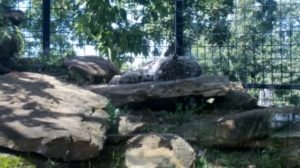
Overall Rating
![]()
The Rolling Hills Zoo is a young Zoo founded in 1999 in Salina, KS. They have 60 acres with approx. 100+ species of animals. The Zoo is an accredited member of the Association of Zoos and Aquariums and participates in the AZA program called the Species Survival Plan. The Zoo admission also includes an independent walking tour of the onsite museum which houses a collection of 1,500 full mount taxidermy animals. The largest collection of taxidermy animals in Kansas.
Rolling Hills Zoo Website: www.rollinghillszoo.org
Hours:
Winter (November 6-March 12) 9:00am-4:00pm
Spring (March 13-May 26) 9:00am-5:00pm
Summer (May 27-September 4) 8:00am-5:00pm
Fall (September 5-November 4) 9:00am-5:00pm
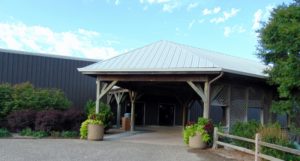
Closed:
Thanksgiving Day
Christmas Eve
Christmas Day
New Year’s Day
Ticket Pricing:
Adults (13-64)-$15.00
Seniors (65+)-$14.00
Kids (3-12)-$9.00
Kids 2 & under-Free
Parking: Free
Pet Daycare:
The Zoo does have a Pet Daycare (Free) for families traveling with their pets.
With any extra service provided I would always call ahead for any information.
Restaurants:
The Overlook Concession is open seasonally.
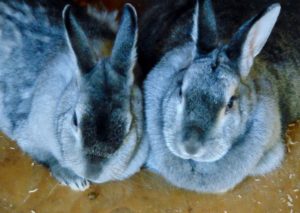
Animal Habitats![]()
Education![]()
Cultural Immersion![]()
Navigation![]()
Food Variety![]()
Click here to check out our Ratings Page.
Our Zoo Experience
We visited Rolling Hills Zoo located in Salina, Kansas, in August. The weather was great! The zoo is approx. sixty acres. We were able to walk through and see all the exhibits and animals in about a half a day.
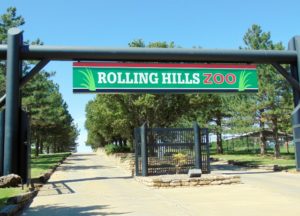
This is probably the youngest zoo we have visited so far. They have built wonderful habitats for all of their animals. Their staff was some of the friendliest and most hospitable zoo employees we have encountered so far. They had a wonderful little restaurant with a good variety of offerings.
The zoo is a bit spread out due to the zoo growing in size, so be prepared to get your steps in.
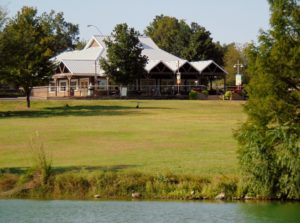
There is a museum at Rolling Hills which contains the largest collection of taxidermy animals in the world.
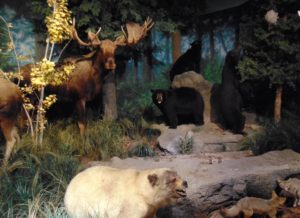
I thought the museum was going to be creepy and weird, however, it turned out to be pretty awesome. Let me set the scene: first, you step into what appears to be an African Savanna with some Lions staring at you while a few male Lions surround a Buffalo. There’s no fence. There’s no glass. There’s just Lions.

Steve and I looked at each other and literally at the same time said “are they real?” Obviously, we had realized they weren’t living, breathing Lions, but it had not sunk in yet that this was a massive collection of taxidermy animals.
We’ll talk more on that later.
I also wanted to mention something about cultural immersion for this zoo. We normally do not say too much about a zoo’s individual ratings. We don’t want to bore you with our exhaustive process. However, I wanted to mention the museum alone moved this zoo from a one paw rating to a two paw rating on cultural immersion.
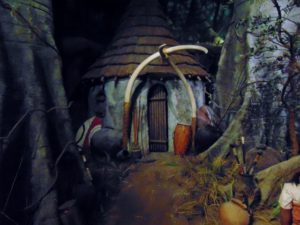
The museum will take you on an immersive journey all around the world! We really wanted to see more of that cultural immersion in other parts of the zoo! As we’ve said before, a zoo’s cultural immersion can really help solidify the zoo visitor’s understanding of a species’ place and importance our world!
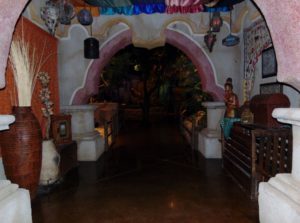
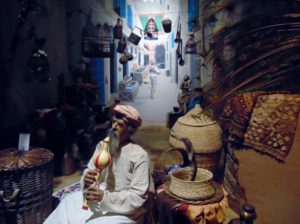
OK, so back to our zoo experience!
After purchasing your ticket you will exit the side of the building (main building) and make your way down a gravel path.
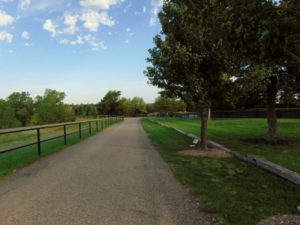
The Discovery Center and Kids Country is the first exhibits you come to. In the Kids Country you will encounter your typical Farm/Ranch animals.

These include Cows, Sheep, Llamas, Goats, and Chickens.
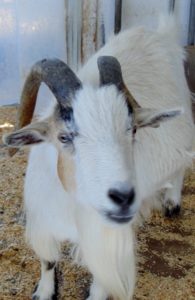
The zoo has a Miniature Zebu which a species of African Cattle. The Zebu lives in the Kid’s Country exhibit. Steve was able to find her sweet spot to scratch right under her chin.
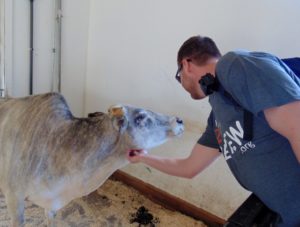
To your left you will see the African Lion habitat. The male African Lion we saw has the biggest most beautiful mane. He has a wonderful habitat with great elevation.
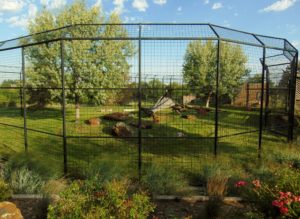
Next we walked down a small incline to the Andean Bear habitat. She was soaking up the sun the day we visited.
Do you know how to tell an Andean Bear (Spectacled Bear) from other bear species? Andean Bears usually have rings of white or light colored fur around their eyes.
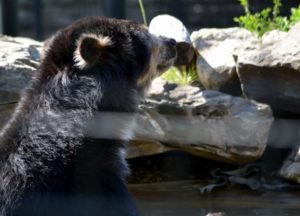
The Andean Bear (Spectacled Bear) is South America’s only bear, they are found throughout the dense jungles of the Andes Mountains. Across from the Andean Bear is the Pronghorn habitat.
Pronghorn are North America’s fastest land mammal. Their range extends from Canada down to north Texas.
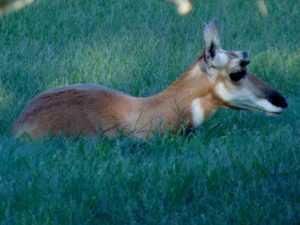
After seeing the Pronghorn we decided to take the next left which took us to the Addax and Scimitar-horned Oryx habitat.
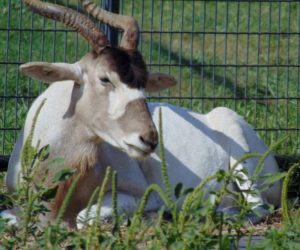
The Scimitar-horned Oryx is one of the most endangered antelope species on the planet. They actually went extinct in the wild in 2000. In the past couple years there has been a small number of Scimitar-horned Oryx released back into the wild.
Thanks in part to the dedicated zoos and their staff. Also due to the Species Survival Plan which many zoos are part of. So there is hope for the species.
To the right, across from the Addax and Oryx habitat is Lemur Island, home to the zoo’s Ringtail Lemurs. Did you know a group of Lemurs is called a Conspiracy?
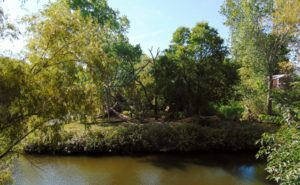
After watching the Lemurs sunbathing you can take another left and follow the path past the African Crowned Cranes.
The Cranes habitat is next to the zoos Giraffe herd. The zoo has two different species of Giraffe (Maasai and Reticulated).

Across from the Giraffe habitat is the Wallabies and Red Kangaroo habitats. Wallabies and Kangaroos are Marsupials, which means they have pouches in which their babies live for several months after they are born. When a Joey is born they are no bigger than a grain of rice.
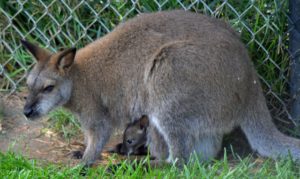
We were standing at the Wallabies habitat admiring how adorable these little cuties are when Steve pointed out that the mama Wallaby had something in her pouch. She was caring a baby Joey in her pouch. Every once in a while the little one would stick its head out of mama’s pouch and nibble on some grass.
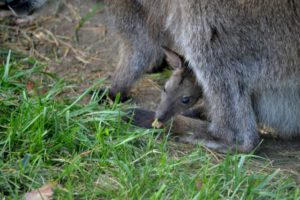
The Rhino Barn and habitats are next. The zoo has two species of Rhino. The Greater One-horned Rhino (Indian Rhino) is native to Nepal and India. They also have the White Rhino found in South Africa, Namibia, Zimbabwe, and Kenya.
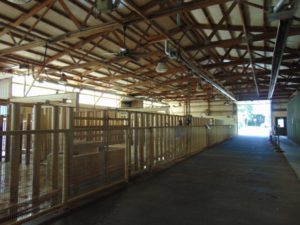
Inside the Rhino Barn are Cotton-topped Tamarins. The Tamarins were in the Rhino barn because it was their breeding season during our visit. There were signs asking visitors to please be quiet as to not stress the little cuties out.
On down the path you can encounter Ostrich and Dromedary Camels. Did you know Ostrich are the largest birds in the world? They are also flightless, and no they do not stick their heads in the sand when they are frightened.
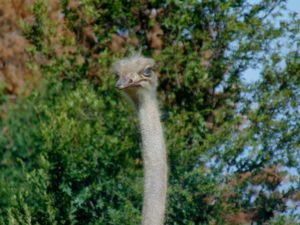
There was a male Camel being naughty and sticking his head and neck through the fence to eat the grass growing just outside the fence. Steve and I had a chuckle…”Is the grass greener on the other side?”
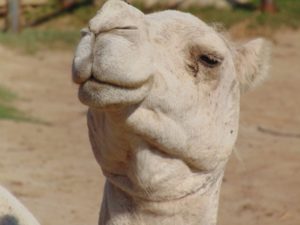
Do you know how you can easily tell the two Camel species apart? Bactrian Camels have two humps, their name starts with a B; turn the B on its side and it has two humps too.
The Dromedary Camel has one hump, their name starts with a D turn the D on its side and it has one hump too. Pretty neat, huh?
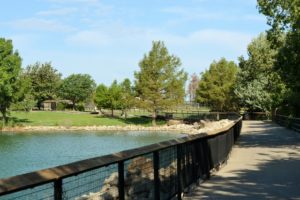
A short trek from the Camels habitat will take you to the Sichuan Takin (rhymes with rockin’) habitat. There is a covered viewing area above the Takin habitat. This allows you to see the Takin no matter where he might be in his habitat.
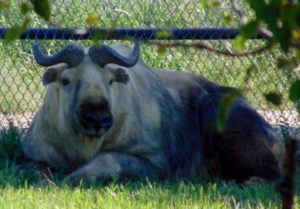
The Takin might look like a species of antelope, however, it is actually a species of Goat. The Takin is endemic to the Sub-Alpine Forests and Alpine Meadows of western China and the Himalayas. The Takin is considered vulnerable.
Once we were finished admiring the Takin, we trekked a bit more down the path. The next species, I knew what it was before I saw it, because I could smell it. It was a South American Maned Wolf. They have a very distinct smell. Their nickname is the Skunk Wolf.
Across from the Maned Wolf habitat is a building. This building has both outdoor and indoor viewing for visitors. This building houses an Aardvark from Africa and a Giant Anteater native to South America.
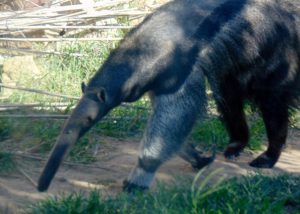
Rolling Hills, Memphis, and Henry Doorly Zoo (located in Omaha, NE) are the only zoos we have encountered Aardvarks to date.
Behind the Aardvark and Anteater’s building is the zoo’s Herpetarium.
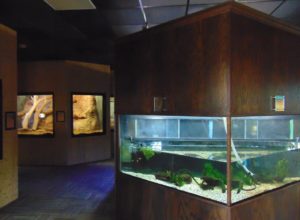
The zoo has some really neat habitats and species.
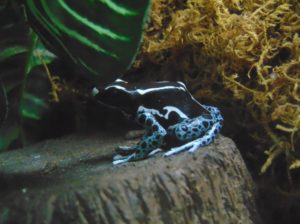
Before you enter the Herpetarium is the habitat for the Aldabra Tortoise. They were snuggled up together enjoying the afternoon sun.
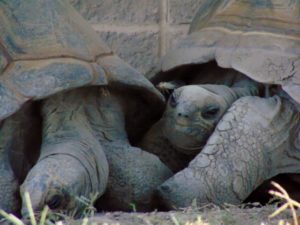
The Aldabra Tortoise can live to be 250 years old. Most however, live between 80 and 120 years of age. If you are ever considering getting any kind of Tortoise as a pet and they do make wonderful pets for the right home; please make sure the Tortoise is going to be cared for when it most likely out lives you.
The have Amphibians like the Dying Poison Dart Frog and the Smoky Jungle Frog. There are even cool Sonoran Desert Toads.
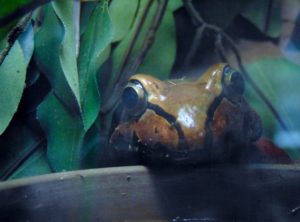
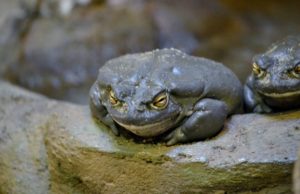
There is a Lizard species called a Quince Monitor with the most beautiful pattern. Quince Monitors are native to Indonesia.
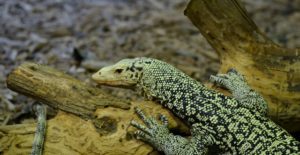
The Grand Cayman Iguana habitat is awesome. He has a log he likes to climb, it gives him a good vantage point to see out over his domain.
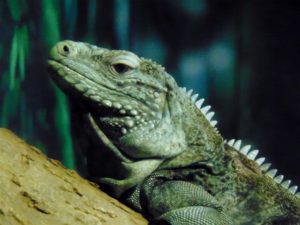
Their Burmese Python was coiled up and hangout in its temperature controlled habitat.
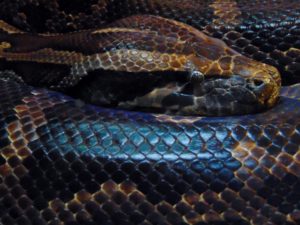
Of course the Common Chuckwallas were front and center and hamming it up for our cameras. Any time there is a Chuckwalla at a zoo we visit they are always waiting to get their picture taken. We always have a good chuckle about how much of a ham for the camera they are.
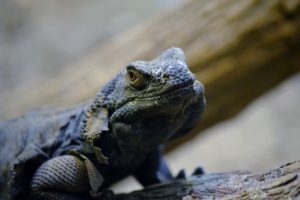
One of the coolest habitats in the Herpetarium is for Madagascar Hissing Cockroaches. The keepers built these little guys their very own city, complete with skyscrapers and cars on city streets. It is one of the most unique habitats we’ve seen so far.
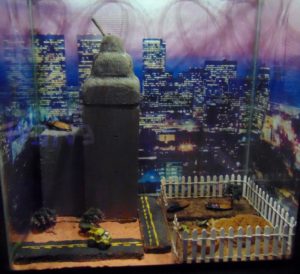
The next habitats you will encounter are for the Primates. The Primate habitats also have outdoor and indoor viewing.
One thing about the zoo’s indoor Primate viewing area that stuck with me is a sign asking visitors to please be quiet. I really appreciate that. It drives me bonkers when people are being loud at an animal’s habitat.
I know people get excited, I do too. There is probably no one that gets more excited than I do. However, the animals can hear as well as or better than we can, so they know when we are there with them. Ok, soapbox rant over. Thanks for listening.
Anyway, the Keepers had just let the Sumatran Orangutans and Chimpanzees out into their outdoor habitats, respectively. The Orangutans and Chimpanzees are let outside to forage and interact socially in different enrichment activities.
The two Orangutans were kind of like “Meh, I’m just going to go hangout” and worked their way up to the top of their habitat.
The Chimps were a bit more active. There was one Chimp that was a little mischievous, you could see it in her face. The mischievous Chimp was swinging and running all over the habitat. She was also stealing a certain kind of fruit or vegetable (their snacks) before any of the other Chimps could get it. She was also very particular about one of the enrichment toys. It was like watching a toddler at daycare who doesn’t like to share.
There was a T in the road so we of course went left toward the Mandrill’s habitat. If you have ever watched the Lion King and know who Rafiki is, then you know what a Mandrill is. Only the male Mandrills have the vibrant blue and red colors on their face. They also have extremely long canines.
The exhibit we came to next was the big cats. The zoo has four species of big cats. The Amur Leopard, Tiger, Mountain Lion, and Snow Leopard.
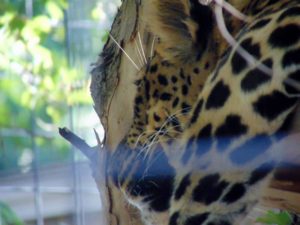
The Mountain Lion is also known as Screamer, Puma, Panther, or Cougar depending on where you are from. The Mountain Lion is native to North America.
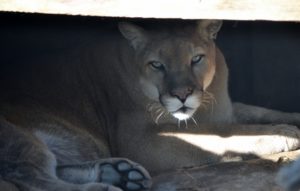
The other three big cats are all found in Asia. The Amur Leopard and Tiger are the most endangered out of the four big cats found at Rolling Hills Zoo.
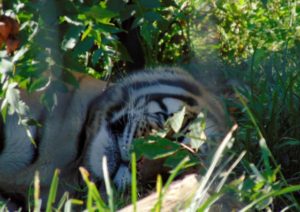
As the path circles around on your left will be an island habitat full of Chilean Flamingos.
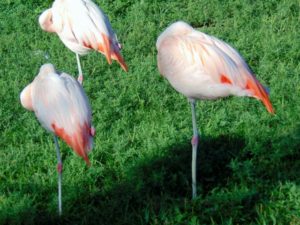
The Rolling Hills Zoo does offer food and has a Restaurant located between the Flamingos and Prairie Dogs.

The Overlook Restaurant has Hamburgers, Hot Dogs, Corn Dogs, and Chicken Strips to name a few different offerings. On the day we were visiting the zoo, the Overlook Café had Taco Salads as their daily special.

The portion size was huge, Steve and I could have easily spilt the Taco Salad. Steve had a Hamburger and Fries and I ate almost all of my Taco Salad, it was delicious.

As we have mentioned before, the zoo staff were extremely hospitable. The Overlook staff were no different. Like we say in the ratings page, we do not rate a zoo on food service, but if we did, the Overlook would get 5 paws out of 5.
After we had lunch, we headed in the direction of the African Painted Dogs habitat. Right across from the Painted Dog habitat is the Black-tail Prairie Dog habitat. Unfortunately they were underground (I assume sleeping) so we did not get to see these little cutie pies.
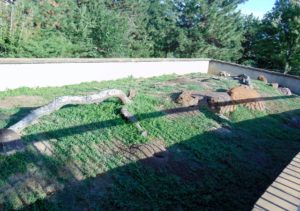
Just before the Painted Dogs habitat is the Coati (Coatimundi) habitat. They have a tunnel under the Coati habitat. You can crawl into the tunnel and pop your head up inside a bubble (so to speak) inside the Coati habitat.
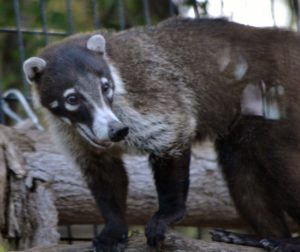
It’s really a box with Plexiglas on all sides with a roof. This box lets you stand (or kneel if you are an adult) and get up close and personal with the Coati. It is super neat for kids to get to have a close encounter with an animal.
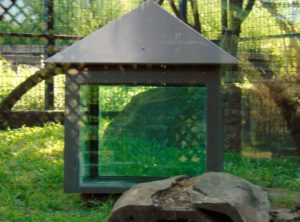
The only other habitat like this, is in the Children’s Zoo at the Dallas Zoo and Memphis Zoo. So after Steve crawled in and out of the Coati tunnel we headed to the African Painted Dogs.
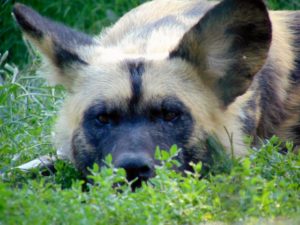
If you have never heard what a Painted Dog sounds like pay close attention when at their habitat. Maybe you will get the chance to hear them. They have a little squeak and whistle that is very high pitched. They sound nothing like a dog sounds. Truly awesome but totally bizarre at the same time.
After we were finished walking the zoo we visited the Rolling Hills Zoo Museum.
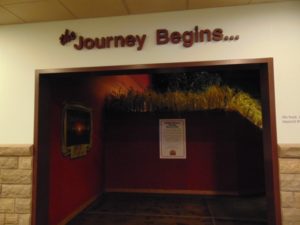
Like I said previously it is the largest collection of Taxidermy animals in the world. The museum is, 64,000 square feet with four waterfalls, animatronics, and hundreds of animals.
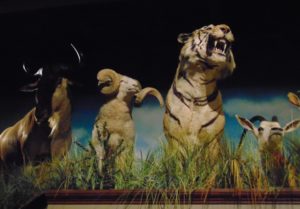
The places you visit and the animals found in these places are remarkable. As I said before, it is not as creepy as one might think, well maybe the animatronic people are.
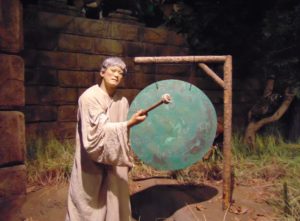
You will visit the following places: Rainforests, Far East (Great Wall of China), Middle East Desert, Europe, Polar Region, Yukon Mining Village, North America, African Jungle, and African Plains.
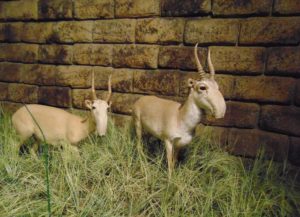
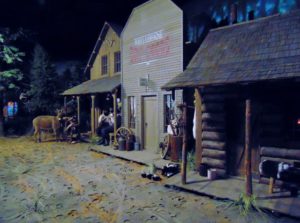
You will see exhibits like Survival of the Fittest in the African Desert, the Zambezi River, and African Waterfall.
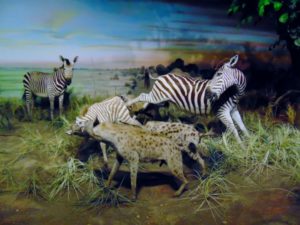
You can walk amongst a Southwest Native American Kiva and Southwestern Buttes.
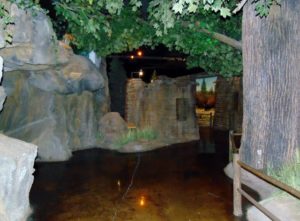
You will also see what Forest Life and the Land of Ice and Snow are like and the animals that thrive there.
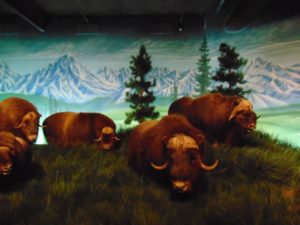

Overall the Rolling Hills Zoo is a do not miss experience. Steve and I drove up to Salina after visiting the Sedgwick County Zoo. We really enjoyed seeing all the animals, learning about new species, and visiting an extremely unique museum. We highly recommend stopping if you are near Salina Kansas. I can’t wait to visit again.